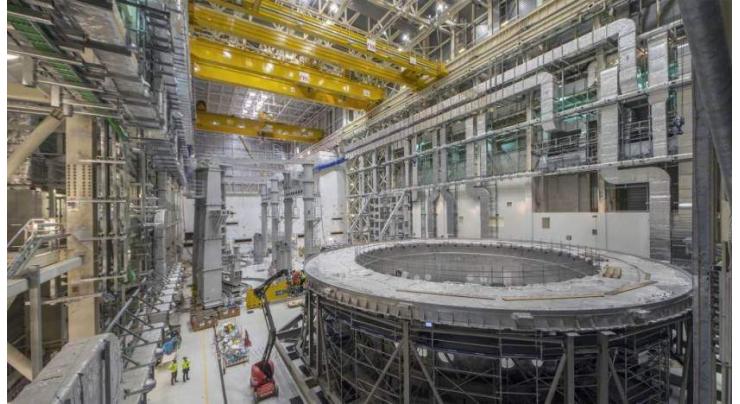
- Home
- World
- News
- Global Community Makes Important Step Toward Fusion Power by Launching ITER Construction
Global Community Makes Important Step Toward Fusion Power By Launching ITER Construction
Muhammad Irfan Published August 22, 2020 | 12:02 AM

Humanity has achieved a crucial milestone on the path to the use of fusion power as a large-scale source of energy by launching the construction of the International Thermonuclear Experimental Reactor (ITER), experts told Sputnik
MOSCOW (UrduPoint News / Sputnik - 21st August, 2020) Humanity has achieved a crucial milestone on the path to the use of fusion power as a large-scale source of energy by launching the construction of the International Thermonuclear Experimental Reactor (ITER), experts told Sputnik.
The assembly of ITER, a long-delayed international megaproject, has started last month in southern France. Some 35 countries, including Russia, the United States and China, are collaborating on this project. ITER aims to prove that fusion, the process that powers the sun, can become a major carbon-free source of energy. The reactor is expected to produce first plasma in December 2025 and begin deuterium-tritium fusion experiments in 2035.
COSTLY EXPERIMENT FOR THE SAKE OF FUTURE ENERGY SOURCES
Even though ITER has been in the works for decades and will probably cost some $65 billion, it is expected to generate important output which would determine whether fusion power could become a new electricity producing source, according to experts.
"I believe ITER will be a great success as a research facility. It will allow to test plasma physics and the properties of Tokamak in a completely new domain close to where fusion reactors should operate. We will learn a lot from this facility," Jean Barrette, professor emeritus with McGill University's Department of Physics, told Sputnik.
Felix Hofmann, professor with the University of Oxford's Department of Engineering Science, joins Barrette in his optimism regarding ITER's chances to succeed in its goal.
"ITER certainly is a very exciting step in the quest for fusion energy. While the headline aim is to demonstrate the feasibility of large-scale fusion, I think its most valuable function will be to highlight which aspects of the technology are ready and where more work is needed for commercial operation. This will be especially exciting from a research perspective," Hofmann told Sputnik.
The integration of fusion power into the energy mix has been long overdue, according to Daniel Kammen, the professor of energy at the University of California, Berkeley.
"I am very excited to see this milestone for ITER. This is a fantastically positive and very important step to commercial fusion. I do believe that ITER will both function, and set a test and pilot project for commercial plants, the costs are very much uncertain. The integration of fusion for both commercial power and for space travel are both long overdue and very important to our long-term energy needs," Kammen, a former World Bank Group's chief technical specialist for renewable energy, told Sputnik.
Over the years ITER has, however, received its share of criticism. Some believe that even if the project manages to achieve its goal, fusion power will remain utterly expensive and commercially unviable. Moreover, ITER itself will be incapable of producing enough power for net electrical production.
"I am not sure however that the result of this research would lead to economical solution for the building of fusion reactors on a tokamak design. This is still an open question. Even if greatly successful, I believe that the commercial application of such reactors will take at least 50 years partly because of the complexity of the system. Its optimization would require the construction of a few generations of initial reactors," Barrette said.
Whether fusion power could be commercialized remains to be seen. But there are already plans to build upon the ITER experiment in order to rationalize the use of fusion. The DEMOnstration power plant is expected to be ITER's successor. DEMO might hook fusion electricity to the grid and generate some 300-500 Megawatt net electricity. The launch of construction is slated for 2040.
Related Topics
Recent Stories

Delegation of international investors meets Finance Minister

Federal Govt stands with Balochistan for its development: Naqvi

UAE President receives condolences of Prime Minister of Pakistan over passing of ..

ECC approves to enhance wheat procurement targets

UN urges Israel to 'stop escalation' as tanks enter Gaza's Rafah city

EU stumps up $125 mn for Yemen after aid groups' plea

Governor Tessori condemns May 9 riots, calls it a 'pre-planned conspiracy'

PM condoles with UAE President over Sheikh Tahnoun’s death

Milan nets Giro 4th stage, Pogacar retains lead

UBS back in profit after Credit Suisse takeover losses

Asiya Gul lauds Shafaat's services as DG LG

President for dialogue with all political forces in Balochistan
More Stories From World
-
Slovakia records 1,100 bomb threats in a day, launches terror probe
4 hours ago -
Football: UEFA Champions League result
4 hours ago -
Equipment of Pakistani peacekeepers begins to move out as UN mission to D.R. Congo ends
5 hours ago -
Ramos joins Mbappe and Dembele in PSG attack against Dortmund
6 hours ago -
Paris Saint-Germain v Borussia Dortmund Champions League starting line-ups
6 hours ago -
Saudi transportation, logistic sector ready for smooth Hajj pilgrimage
6 hours ago
-
Italy PM Meloni signs cooperation deals in Libya visit
6 hours ago -
Brazilians queue for precious water as flood damage intensifies
6 hours ago -

UAE President receives condolences of Prime Minister of Pakistan over passing of Tahnoun bin Mohamme ..
7 hours ago -

UN urges Israel to 'stop escalation' as tanks enter Gaza's Rafah city
7 hours ago -

EU stumps up $125 mn for Yemen after aid groups' plea
7 hours ago -

China voices serious concern over Israel's plan to launch military operation against Rafah
9 hours ago



